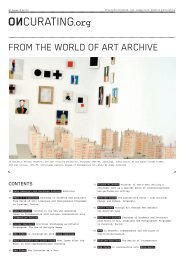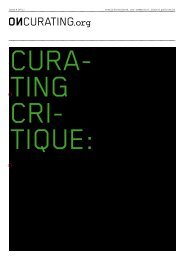You also want an ePaper? Increase the reach of your titles
YUMPU automatically turns print PDFs into web optimized ePapers that Google loves.
045 Issue # 11/11 : PublIc Issues<br />
In the early 1980s the Federal District w<strong>as</strong> the most densely populated area in the<br />
country but it underwent major readjustment following the 1985 earthquake, part of the<br />
population of the central districts worst hit by the dis<strong>as</strong>ter moving to the south of<br />
the city. This resulted in these are<strong>as</strong> becoming populated by younger people, who popu-<br />
larized them, eventually leading to a process of gentrification, which is currently<br />
under way in another of the districts most severely affected by the quake, the Historic<br />
Centre. The nature of these districts h<strong>as</strong> thus changed from being residential to mainly<br />
commercial.<br />
In 2003 the city officially exceeded the territorial limits of the Federal District and<br />
h<strong>as</strong> since been known <strong>as</strong> the Metropolitan Zone of Mexico City (ZMCM). This includes the<br />
entire metropolitan area that is part of the urban sprawl of the neighbouring states.<br />
Even under a new name the city is still v<strong>as</strong>t. One of the works that documents this sheer<br />
magnitude is spiral city (2002) by British artist Melanie Smith. In it she records the<br />
urban sprawl in a 5 minute video shot from a helicopter following the spiralling lines<br />
of Robert Smithson. The black and white video ultimately reduces the city to a grey<br />
texture.<br />
But seen from close up, there is not just one Mexico City, there have been many through-<br />
out history. What used to be the lake around the island of Tenochtitlan is now paved<br />
over, traversing it involves moving back and forth through the ages, exploring the syn-<br />
cretism evident in its architecture and social relations.<br />
The City of the Palaces<br />
The loss of economic capacity in Mexico h<strong>as</strong> profoundly affected its architectural<br />
development and urban development, which in the p<strong>as</strong>t h<strong>as</strong> proved more ple<strong>as</strong>ing to its<br />
inhabitants. The generous architecture, planned and crafted, h<strong>as</strong> gradually been re-<br />
placed by minimally functional structures, economical materials, standard designs and<br />
standard me<strong>as</strong>urements, creating residential spaces that appear to be built on the<br />
socio-economic scale of the majority of the population, rather than on a human scale.<br />
With a recent project that took the form of sculptural work, a film and a play, Abraham<br />
Cruzvilleg<strong>as</strong> performs the important t<strong>as</strong>k of analyzing the urban practice known <strong>as</strong> self-<br />
building (fig. 4). Using personal historical references <strong>as</strong> a starting point, he comes<br />
to see it <strong>as</strong> a warm-hearted process in which solidarity between neighbours and family<br />
members is fundamental, not just <strong>as</strong> shared capital but also <strong>as</strong> an educational envi-<br />
ronment that helps any individual who is part of a community to understand their own<br />
situation. And it is precisely this practice of self-building that h<strong>as</strong> created the<br />
working cl<strong>as</strong>s residential are<strong>as</strong> in which spaces such <strong>as</strong> markets, squares and streets<br />
fulfil their true function <strong>as</strong> social public spaces.<br />
4 — Abraham Cruzvilleg<strong>as</strong>, Autoconstrucción: The Film, 2009, Courtesy of Galería Kurimanzutto.<br />
Mexico City.


![Download as PDF [10.6 MB]](https://img.yumpu.com/4266533/45/500x640/download-as-pdf-106-mb.jpg)

